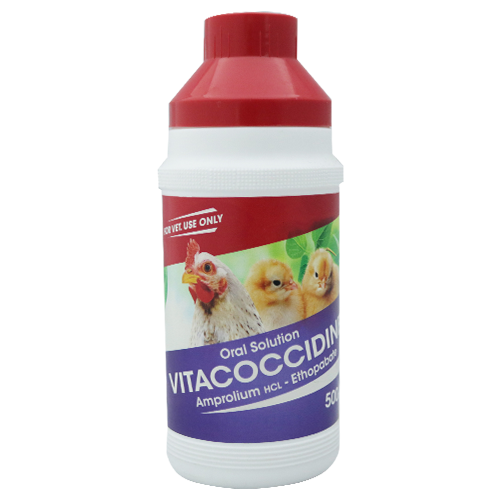
VITACOCCIDINE
Dual action for coccidia free herd
COMPOSITION
- Each 1 liter contains:
Amprolium HCL 244.25 gm (Eq. to Amprolium base 216 gm) Ethopabate 1.4 gm
AMPROLIUM
Amprolium is an organic compound anticoccidial agent (coccidiostat effect) that is a competitive inhibitor of thiamine in the parasite metabolism By blocking thiamine uptake (thiamine pyrophosphate) is a cofactor of several decarboxylase enzymes which play role in carbohydrate synthesis. So it prevents carbohydrate synthesis and interferes wall formation of the oocysts, characterized by few resistance.
ETHOPABATE
It is an arylamide containing one phenyl ring, belonging to monocyclic aromatics aromatics, is a very safe drug. It has anticoccidial activity especially against intestinal forms. This durg is a competitor of PABA for absorption by the parasite and interferes with folate synthesis. It has good activity against E. acervulina and some strains of E.maxima and E. brunette, which improves the coccidiostatic effect of amprolium.
INDICATIONS
Broiler chickens:
Treatment of intestinal coccidiosis caused by Eimeria spp as Amprolium Antiprotozoal activity: It is active against Eimeria tenella, E. necatrix, E. praecox, E. mitis, E. meleagrimitis, E. adenoeides, E. gallopavonis, E. acervulina and E.brunetti.
It is effective against other protozoal infections like:
- Histomoniasis (blackhead) in turkeys and poultry.
- Coccidiosis in calves, sheep and goats.
- Amaebiasis in various Species.

TARGET SPECIES
Broiler chickens, turkey
DOSAGE OF ADMINISTRATION
Route: oral via drinking water.
- 50-100 gm of Product/100 litres of drinking water for 5 – 7 days, followed by 25gm per 100 litres of drinking water during 1 or 2 weeks.
- 5-25gm/kgbwt for 5-7 days
WITHDRAWAL PERIOD
Broiler chickens (Meat): 5 days
Laying chicken (Egg): 10 days
STORAGE
Store at temperature not exceeding 30C.
PACKAGING
500 ml & 1 liter oral solution
Reference
- LEESON’, ENG-HONGLEE’Z, and J. D. SUMMERSI 1Department of Animal and Poultry Sci-ence, and 2Department of Pathology, Uni-versity of Guelph, Guelph, Ontario NIG 2W1.
Received 11 Jan. 1984, ac-cepted 4 Apr. 1984.
—————————————————————–
- Chapman,H.D.,1996.Anticoccidialdrug programs in the United States. Poultry Sci. 75 (Suppi. 1): 90.
—————————————————————–
- Edgar,S.A., 1986. Coccidiosisinturkeys: Biologyandincidence. In:Researchin Avian Coccidiosis.
Proceedings of the Georgia Coccidiosis Conf. Nov. 1985, University of GA, Athens.
—————————————————————–
- Gregory,M.W., 1990. Pathologyofcoccidialinfections. In:CoccidiossisofManand Domestic Animals. Ed. P.L.Long, CRC Press, Boca Raton, FL.
—————————————————————–
- Beach, J.R., 1943. A rapid method for quantita – five counts of coccidial oocysts in chicken feces. Cornell Vet. 33 : 308-310.
—————————————————————–
- Cuckler, A. C, and C. M. Malanga, 1955. Studies on drug resistance in coccidian. J. Parasitol. 41 : 302-311.
—————————————————————–
- Edgar, S. A., 1958. Problems in the control of coccidiosis. Semi-annual Meeting, Amer. Feed. Manufacturers Assoc, Chicage, 111. p. 19-26.
Gardiner, J. L., and D. K. Mcloughlin, 1963a. Durg resistance in Eimeria tenella. lll. Stabil- ity of resistance to glycarbylamide. J. Para- sitol. 49: 657-659.
Manufactured by Badr Pharama for Newvet group Trooper Pharma
411 , zone 9, 10th of Ramdan, Egypt Telefax: (002) 0554 366 707
